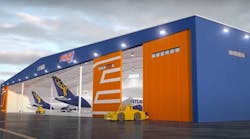SAVANNAH, Ga., August 15, 2012 — At São Paulo’s Latin American Business Aviation Conference & Exhibition (LABACE) 2012, Gulfstream Aerospace Corp. President Larry Flynn reaffirmed Gulfstream’s commitment to expanding support for its growing Latin American fleet, especially with two new models nearing entry-into-service.
“We have established our first factory service center in Latin America in Sorocaba, Brazil, and this will become an increasingly important hub for us,” said Flynn.
The Sorocaba facility, 97 km from São Paulo, is a 24,000-square-foot hangar that can accommodate a mix of four to six large- and mid-cabin aircraft, and also includes 8,000 square feet of offices and a 3,000-square-foot bonded parts warehouse. It is certified to perform maintenance, repairs and alterations on all Brazil-registered Gulfstream aircraft. It can also service U.S.-registered Gulfstream aircraft with Federal Aviation Administration-certified technicians.
“Ensuring we have the right resources in the right places for our operators, who are increasingly spread out around the world, is extremely important and a driving factor behind our growth,” Flynn said. “Around the world, we already have begun preparing for the entry-into-service of our two newest aircraft, the Gulfstream G650 and G280
“We are thrilled with the performance of these aircraft and know that our customers will be, too.”
The G280, he noted, is the performance leader in its class, with a range of 6,667 km (3,600 nautical miles) at Mach 0.80 and takeoff capability under 5,000 feet.
“The G650 establishes a new class, with unparalleled capability, including a top speed of Mach 0.925,” Flynn said. “It flies faster and farther than any other business jet, and in a level of comfort far greater than any other aircraft in its class.”
Flynn noted that the world economy has been challenging for business aviation, and Gulfstream is addressing this by investing in new aircraft and an expanded worldwide support organization.
“We are doing what it takes to make sure our customers have the most capable aircraft with the best support,” he said. “The imperative to conduct business internationally will not change, and that means that Brazil and other countries will need the kind of high performance, long-range aircraft we provide.
“The Gulfstream fleet in Brazil has increased from nine aircraft in 2006 to 36 aircraft today, and three-quarters of those are large-cabin, long-range models suited for travel to Europe, Asia and elsewhere,” Flynn said.
In that same period, the Gulfstream fleet in Latin America has grown from 58 jets to 150, predominantly large-cabin, long-range models. Gulfstream has more than 2,000 jets in service, with Latin America representing nearly 8 percent of its worldwide fleet.
“We’re investing for the long-term and are quite optimistic about the future of Gulfstream in Brazil, in Latin America and around the world,” Flynn said.



